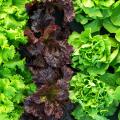Okra
Okra

Okra is a hot-weather vegetable. Most varieties make large plants that require a fair amount of garden space. When two rows are planted side by side, leave extra space between the rows and on both sides to allow for easy harvesting.
Okra seeds are hard. Soak them in water overnight before planting to speed germination.
Space the seed about 4 inches apart in the row and thin seedlings to the recommended spacing, or plant groups of two or three seeds at the recommended final spacing and thin seedling groups to one plant. Planting through black plastic mulch is recommended to promote earliness. Okra seedlings are sensitive to cool, wet soils and cool air temperatures. Acid soils result in poor pod development.
A second planting of okra seeds about 6 weeks after the first planting ensures plenty of tender pods in late summer and fall when production on the early planting is declining.
Cut back tall okra plants to a height of 3 to 4 feet to promote branching, to make harvesting easier, and to renew the plants. Side-dress with a nitrogen fertilizer at the same time.
Harvest okra pods by snapping or cutting frequently. Even the spineless varieties cause some skin irritation, so wear long sleeves when harvesting.
Disease problems are generally minimal, but okra is sensitive to root knot nematodes. Insect pests are corn earworms, stink bugs, and ants.
Varieties
- Annie Oakley—hybrid; Clemson Spineless type; spineless pods slightly ribbed.
- Burgundy—burgundy-colored pods; dwarf plants grow to only 4 feet; plant has ornamental appeal with red in stems and leaves; AAS 1988.
- Cajun Delight—five-sided; dark green pods.
- Clemson Spineless—leading home garden variety; straight pods tapered, ridged, spineless; less foliage than Perkins Spineless; 65 days; AAS 1939.
Publications
News
Vegetable producers across the Southeast are invited to the 2025 Vegetable Field Day on July 23 at the Mississippi State University station in Verona, Mississippi.
If you grow your own vegetables, you will likely see at least a few pesky insects that want to feed on your plants. Slugs are one of the pests you may be noticing now.
Did you know yellow squash is in the pumpkin family and are 95 percent water?




